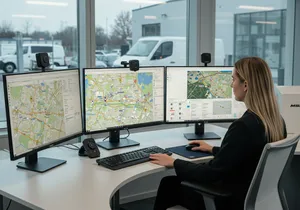Real-time GPS Tracking
- Current speed and direction monitoring
- Engine status and diagnostics tracking
- Fuel consumption rate analysis
- Driver behavior metrics collection
- Route adherence tracking and alerts
This page contains GPS tracking information. Use the table of contents to jump to specific sections. FAQ sections can be expanded using Enter or Space keys.
Commercial vehicle tracking devices transform fleet operations through data-driven insights and real-time monitoring. These systems integrate GPS technology, telematics, and analytics to provide detailed fleet visibility and control.
Commercial vehicle tracking devices provide continuous location updates every 30-60 seconds. The system transmits coordinate data through cellular networks to central servers. Fleet managers access location information through web-based dashboards or mobile apps.

Advanced commercial management features include automated reporting systems that generate daily, weekly, and monthly fleet performance summaries. These reports analyze driver behavior patterns, fuel efficiency metrics, and maintenance scheduling requirements.

Essential commercial vehicle tracking systems integrate multiple data sources to provide comprehensive fleet visibility. The platform combines GPS coordinates, engine diagnostics, driver inputs, and external sensors to create detailed operational insights.

Commercial vehicle tracking devices work by using GPS satellites to determine precise location coordinates, then transmitting this data through cellular networks to central monitoring systems for real-time fleet visibility.
The main benefits include improved fleet efficiency, reduced fuel costs, enhanced driver safety, better customer service through accurate ETAs, and comprehensive reporting for operational insights.
Most commercial tracking devices update location information every 30-60 seconds during normal operation, with some systems offering more frequent updates during critical events or emergencies.
Yes, modern tracking devices can monitor various driver behaviors including speeding, harsh braking, rapid acceleration, excessive idling, and unauthorized vehicle use outside business hours.
Fleet managers can generate daily, weekly, and monthly reports covering vehicle utilization, fuel consumption, maintenance schedules, driver performance, route efficiency, and overall fleet productivity metrics.
Tracking devices help with fuel management by monitoring fuel consumption rates, identifying inefficient routes, detecting excessive idling, and providing data to optimize driving behaviors that impact fuel usage.
Most commercial tracking devices are designed to be compatible with various vehicle types including trucks, vans, trailers, construction equipment, and specialized commercial vehicles through different installation methods.
When cellular signal is lost, tracking devices typically store location data locally and automatically transmit the stored information once connectivity is restored, ensuring no data loss occurs.
Commercial tracking systems use encrypted data transmission protocols and secure cloud storage to protect sensitive fleet information from unauthorized access and ensure data privacy compliance.
Many tracking devices offer API integration capabilities that allow seamless connection with existing fleet management software, accounting systems, and other business applications for streamlined operations.
Installation options include OBD-II port connections for easy plug-and-play setup, hardwired installations for permanent mounting, and battery-powered units for temporary or asset tracking applications.
Tracking devices monitor engine hours, mileage, and diagnostic codes to automatically schedule preventive maintenance, send service reminders, and track maintenance history for each vehicle in the fleet.
Yes, tracking systems can send real-time alerts for speeding violations, unauthorized vehicle use, maintenance requirements, geofence violations, and emergency situations via email, SMS, or mobile app notifications.
Geofencing creates virtual boundaries around specific locations, and tracking devices automatically send alerts when vehicles enter or exit these designated areas, helping monitor job sites, customer locations, and restricted zones.
Many insurance companies offer discounts for fleets using tracking devices because they reduce theft risk, improve driver behavior, enable faster vehicle recovery, and provide detailed accident data for claims processing.
Battery life varies by device type and usage, with hardwired units powered by vehicle electrical systems, while battery-powered units typically last 2-5 years depending on reporting frequency and environmental conditions.
Many commercial tracking devices support international roaming through global cellular networks, though data plans and coverage may vary by region and require specific international service agreements.
Tracking devices collect historical route data, traffic patterns, and delivery times to identify the most efficient routes, reduce travel time, minimize fuel consumption, and improve customer service delivery windows.
Most tracking system providers offer 24/7 technical support, online training resources, installation assistance, software updates, and dedicated account management for commercial fleet customers.
Deployment time depends on fleet size and installation method, with OBD-II devices installable in minutes per vehicle, while hardwired installations may require professional installation and take several hours per vehicle.